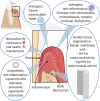Emerging nanomaterials for dental treatments
- PMID: 33200780
- PMCID: PMC7752085
- DOI: 10.1042/ETLS20200195
Emerging nanomaterials for dental treatments
Abstract
The emergence of nanomaterials for dental treatments is encouraged by the nanotopography of the tooth structure, together with the promising benefits of nanomedicine. The use of nanoparticles in dentistry, also termed as 'nanodentistry', has manifested in applications for remineralisation, antimicrobial activity, local anaesthesia, anti-inflammation, osteoconductivity and stem cell differentiation. Besides the applications on dental tissues, nanoparticles have been used to enhance the mechanical properties of dental composites, improving their bonding and anchorage and reducing friction. The small particle size allows for enhanced permeation into deeper lesions, and reduction in porosities of dental composites for higher mechanical strength. The large surface area to volume ratio allows for enhanced bioactivity such as bonding and integration, and more intense action towards microorganisms. Controlled release of encapsulated bioactive molecules such as drugs and growth factors enables them to be delivered more precisely, with site-targeted delivery for localised treatments. These properties have benefitted across multiple fields within dentistry, including periodontology and endodontics and reengineering of dental prosthetics and braces. This review summarises the current literature on the emerging field of nanomaterials for dental treatments.
Keywords: endodontics; nanomaterials; orthodontics; periodontics; prosthodontics; remineralisation.
© 2020 The Author(s).
Conflict of interest statement
The authors declare that there are no competing interests associated with the manuscript.
Figures





Similar articles
-
Polymeric Dental Nanomaterials: Antimicrobial Action.Polymers (Basel). 2022 Feb 22;14(5):864. doi: 10.3390/polym14050864. Polymers (Basel). 2022. PMID: 35267686 Free PMC article. Review.
-
Nanomaterials in dentistry: a cornerstone or a black box?Nanomedicine (Lond). 2018 Mar 1;13(6):639-667. doi: 10.2217/nnm-2017-0329. Epub 2018 Feb 8. Nanomedicine (Lond). 2018. PMID: 29417862
-
Nanodentistry: combining nanostructured materials and stem cells for dental tissue regeneration.Nanomedicine (Lond). 2012 Nov;7(11):1743-53. doi: 10.2217/nnm.12.146. Nanomedicine (Lond). 2012. PMID: 23210714 Review.
-
Organic Nanomaterials and Their Applications in the Treatment of Oral Diseases.Molecules. 2016 Feb 9;21(2):207. doi: 10.3390/molecules21020207. Molecules. 2016. PMID: 26867191 Free PMC article. Review.
-
Review of nanomaterials in dentistry: interactions with the oral microenvironment, clinical applications, hazards, and benefits.ACS Nano. 2015 Mar 24;9(3):2255-89. doi: 10.1021/nn505015e. Epub 2015 Feb 12. ACS Nano. 2015. PMID: 25625290 Review.
Cited by
-
Integrating enzyme-nanoparticles bring new prospects for the diagnosis and treatment of immune dysregulation in periodontitis.Front Cell Infect Microbiol. 2024 Nov 1;14:1494651. doi: 10.3389/fcimb.2024.1494651. eCollection 2024. Front Cell Infect Microbiol. 2024. PMID: 39554809 Free PMC article. Review.
-
Characterization of Ag-Ion Releasing Zeolite Filled 3D Printed Resins.J Funct Biomater. 2022 Dec 22;14(1):7. doi: 10.3390/jfb14010007. J Funct Biomater. 2022. PMID: 36662054 Free PMC article.
-
Emerging Applications of Nanotechnology in Dentistry.Dent J (Basel). 2023 Nov 15;11(11):266. doi: 10.3390/dj11110266. Dent J (Basel). 2023. PMID: 37999030 Free PMC article. Review.
-
Nanotechnology and Its Application in Dentistry: A Systematic Review of Recent Advances and Innovations.J Clin Med. 2024 Sep 5;13(17):5268. doi: 10.3390/jcm13175268. J Clin Med. 2024. PMID: 39274481 Free PMC article. Review.
-
Nanotechnology in dentistry: Bridging science and practice.Bioinformation. 2025 Mar 31;21(3):522-528. doi: 10.6026/973206300210522. eCollection 2025. Bioinformation. 2025. PMID: 40599940 Free PMC article.
References
-
- Zafar M.S., Khurshid Z., Najeeb S., Zohaib S. and Rehman I.U. (2017) Therapeutic applications of nanotechnology in dentistry In Nanostructures for Oral Medicine (Andronescu E. and Grumezescu A.M., eds), pp. 833–862, Elsevier Inc., Amsterdam
-
- Zafar M.S., Alnazzawi A.A., Alrahabi M., Fareed M.A., Najeeb S. and Khurshid Z. (2019) Nanotechnology and nanomaterials in dentistry In Advanced Dental Biomaterials (Khurshid Z., Najeeb S., Zafar M.S. and Sefat F., eds), pp. 477–505, Woodhead Publishing, Duxford
Publication types
MeSH terms
LinkOut - more resources
Full Text Sources
